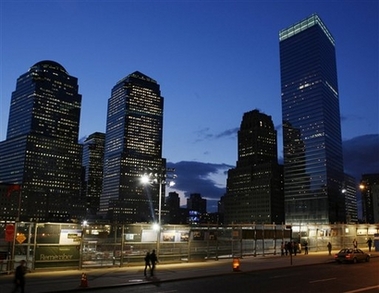NEW YORK - For a few months in 2001, architects
worried that the era of the super-skyscraper was over.
Even as ash from the World Trade Center still swirled, it was clear that the
high floors of the twin towers had been a deadly trap. Experts wondered if
anyone would ever build tall again.

7 World Trade Center,
right, the last building to collapse as a result of the World Trade Center
attacks Sept. 11, 2001, and the first to be permanently rebuilt, rises in
the skyline above ground zero at dusk, Monday, May 22, 2006, in New York.
Skyscraper construction has surged globally since the attacks, prompting
architects and engineers to ponder a new question: What should be done to
make new towers safer? [AP] |
The answer was quickly revealed to be an emphatic "yes." Skyscraper
construction has surged globally since the terrorist attacks, prompting
architects and engineers to ponder a new question: What should be done to make
new towers safer?
That question has been harder to answer.
Architects, engineers and builders have split over the value of several
possible safety enhancements, including better fireproofing, wider stairwells,
and "hardened" elevator shafts that could be used in evacuations.
"You don't want to go about designing every building as if it were a
terrorist target, when the reality is, most aren't," said Ronald O. Hamburger,
past president of the National Council of Structural Engineers Associations.
The debate is likely to heat up in late September, when the International
Code Council begins hearings on proposed revisions to its model building code,
including 19 suggested by the National Institute of Standards and Technology as
a result of its World Trade Center investigation.
If approved, the package would create new rules on the design of exit
stairwells and fire-suppression systems, require fire service elevators in some
towers, and mandate protections against collapse when part of a building is
severely damaged.
Glenn Corbett, a fire protection expert at the John Jay College of Criminal
Justice in New York, said many of the proposed changes have been too long in
coming.
"Are we moving in the right direction? Yes. Are we moving fast enough,
probably not," he said.
Even without major changes to the building code, modifications inspired by
September 11 have begun turning up.
One of the poster children for skyscraper safety now stands at the edge of
ground zero.
The first tower at ground zero to be rebuilt after the attacks, 7 World Trade
Center, boasts some of the most robust safety features ever put in place in a
U.S. office building.
The 741-foot skyscraper was built with a core of thick concrete, rather than
steel. Its beams are protected by five times the fireproofing mandated by code.
Redundant water pipes feed the fire sprinklers in case one line is destroyed.
Evacuation stairwells are pressurized to keep out smoke and are 20 percent wider
than required by law.
The Freedom Tower, now under construction, will have all those features, plus
more, including fortified elevator shafts and stairwells and a bomb-resistant
base.
Carl Galioto, a partner at Skidmore Owings & Merrill, which designed both
buildings, acknowledged that the improvements aren't cheap, and may not be
necessary everywhere.
"Should all of these features be in building codes immediately? No, I don't
think so. It would be really overreaching," he said.
But he said each merits discussion in almost every high-rise building, and
should be seriously considered in towers over 900 feet (275 meters) tall.
There are likely to be plenty of new buildings that meet that height
criteria. Huge new skyscrapers are under construction around the globe,
including at least four expected to be taller than the World Trade Center.
Since 2001, developers have been increasingly willing to consider sacrificing
valuable square footage for safety features, experts said.
Eugene Kohn, a principal at Kohn Pedersen Fox Associates, a designer of some
of the world's tallest buildings, said the use of the concrete core in buildings
has proliferated and some architects are adding extra stairwell capacity and
abandoning the old maxim that elevators should be off-limits to building
occupants during an evacuation.
"If you have to move 10 or 15 or 20,000 people out of these buildings, the
only way to do it with any expediency is to make the elevators part of it," said
Robert Solomon, assistant vice president of the National Fire Protection
Association.
No architects are designing their buildings to withstand a jet aircraft's
impact.
"To do something like that, you wouldn't want to live in that building. It
would be like a fortress. It would be so ungainly looking," Kohn
said.